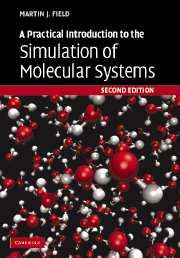Book contents
- Frontmatter
- Contents
- Preface to the first edition
- Preface to the second edition
- 1 Preliminaries
- 2 Chemical models and representations
- 3 Coordinates and coordinate manipulations
- 4 Quantum chemical models
- 5 Molecular mechanics
- 6 Hybrid potentials
- 7 Finding stationary points and reaction paths on potential energy surfaces
- 8 Normal mode analysis
- 9 Molecular dynamics simulations I
- 10 More on non-bonding interactions
- 11 Molecular dynamics simulations II
- 12 Monte Carlo simulations
- Appendix 1 The pDynamo library
- Appendix 2 Mathematical appendix
- Appendix 3 Solvent boxes and solvated molecules
- Bibliography
- Author index
- Subject index
11 - Molecular dynamics simulations II
Published online by Cambridge University Press: 03 December 2009
- Frontmatter
- Contents
- Preface to the first edition
- Preface to the second edition
- 1 Preliminaries
- 2 Chemical models and representations
- 3 Coordinates and coordinate manipulations
- 4 Quantum chemical models
- 5 Molecular mechanics
- 6 Hybrid potentials
- 7 Finding stationary points and reaction paths on potential energy surfaces
- 8 Normal mode analysis
- 9 Molecular dynamics simulations I
- 10 More on non-bonding interactions
- 11 Molecular dynamics simulations II
- 12 Monte Carlo simulations
- Appendix 1 The pDynamo library
- Appendix 2 Mathematical appendix
- Appendix 3 Solvent boxes and solvated molecules
- Bibliography
- Author index
- Subject index
Summary
Introduction
In Chapter 9 we saw how to perform molecular dynamics simulations, although they were not very sophisticated because there was no means of including the effect of the environment. Ways of overcoming this limitation were introduced in the last chapter, in which we discussed methods for calculating the energy and its derivatives for a system within the PBC approximation. As an example, a molecular dynamics simulation for a periodically replicated cubic box of water molecules was performed. Here, we shall start by describing in more detail the type of information that can be computed from molecular dynamics trajectories and also by indicating how the quality of that information can be assessed. Later we shall talk about more advanced molecular dynamics techniques including those that allow simulations to be carried out in various thermodynamic ensembles and those that permit the calculation of free energies.
Analysis of molecular dynamics trajectories
We have seen how to generate trajectories of data for a system, either in vacuum or with an environment, with the molecular dynamics technique. The point of performing a simulation is, of course, that we want to use these data to calculate some interesting quantities, preferably those which can be compared with experimentally measured ones. The aim of this section is to give a brief overview of some of the techniques that can be used to analyse molecular dynamics trajectories and some of the types of quantities that can be calculated.
In Section 9.4 we defined a time series for a property as a sequence of values for the property obtained from successive frames of a molecular dynamics trajectory.
Information
- Type
- Chapter
- Information
- A Practical Introduction to the Simulation of Molecular Systems , pp. 225 - 261Publisher: Cambridge University PressPrint publication year: 2007
